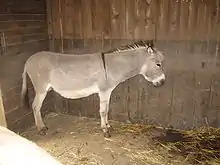Thüringer Waldesel
The Thüringer Waldesel or Thuringian Forest Donkey is a recently created German breed of domestic donkey.
 | |
| Conservation status | DAD-IS (2021): critical[1] |
|---|---|
| Other names | |
| Country of origin | Germany |
| Traits | |
| Weight | |
| Height | |
| Coat | stone-grey with shoulder-stripe and eel stripe[3]: 30 |
| |
History
The Thüringer Waldesel derives from a small group of miscellaneous donkeys collected in Saxony, Saxony-Anhalt and West Thuringia, supplemented with similar-looking donkeys brought from the United Kingdom, and bred both at the Thüringer Zoopark Erfurt at Erfurt in Thuringia, and at the Wildpark Hundshaupten in Egloffstein in Bavaria.[2]: 48 In 2019 the breeding programme was approved by the Landesbetrieb Landwirtschaft Hessen, and the Thüringer Waldesel was recognised as a breed. Seven jennies and two jacks were registered in the stud-book.[4] As there are very few of the donkeys, the breed is reported to DAD-IS as critically endangered.[1]
Characteristics
The Thüringer Waldesel is of medium size. Jacks stand 100–110 cm at the withers, and weigh about 133–210 kg; jennies stand some 95–110 cm, and weigh 156–185 kg.[3]: 30 The coat is usually stone-grey, with dark shoulder-stripe and eel stripe; the legs often display zebra stripes.[3]: 30
References
- Breed data sheet: Thüringer Waldesel / Germany (Ass). Domestic Animal Diversity Information System of the Food and Agriculture Organization of the United Nations. Accessed March 2021.
- Valerie Porter, Lawrence Alderson, Stephen J.G. Hall, D. Phillip Sponenberg (2016). Mason's World Encyclopedia of Livestock Breeds and Breeding (sixth edition). Wallingford: CABI. ISBN 9781780647944.
- Waltraud Kugler, Hans-Peter Grunenfelder, Elli Broxham (2008). Donkey Breeds in Europe: Inventory, Description, Need for Action, Conservation; Report 2007/2008. St. Gallen, Switzerland: Monitoring Institute for Rare Breeds and Seeds in Europe. Archived 2 September 2009.
- Berichte der GEH-Koordinatoren 2019 (in German). Gesellschaft zur Erhaltung alter und gefährdeter Haustierrassen. Accessed March 2021.